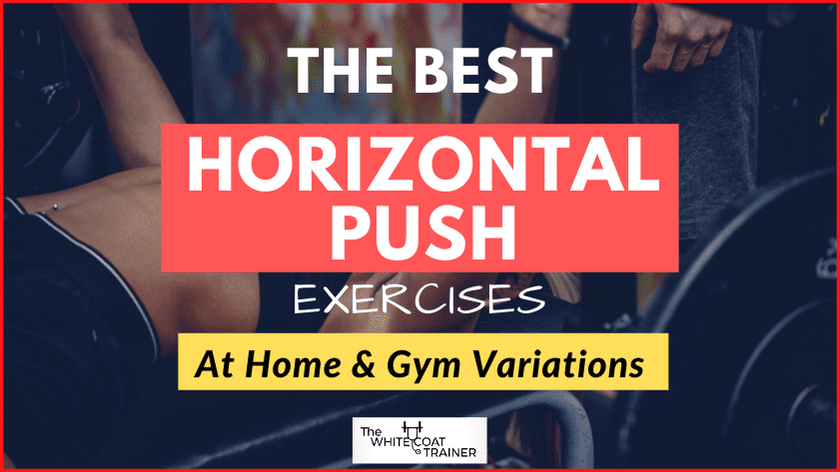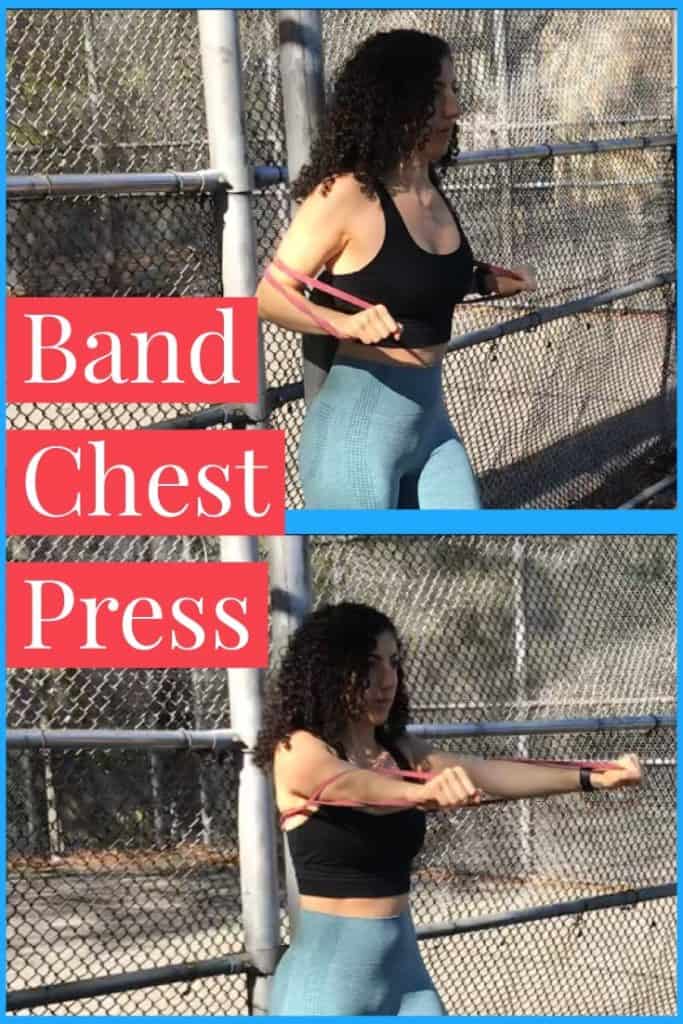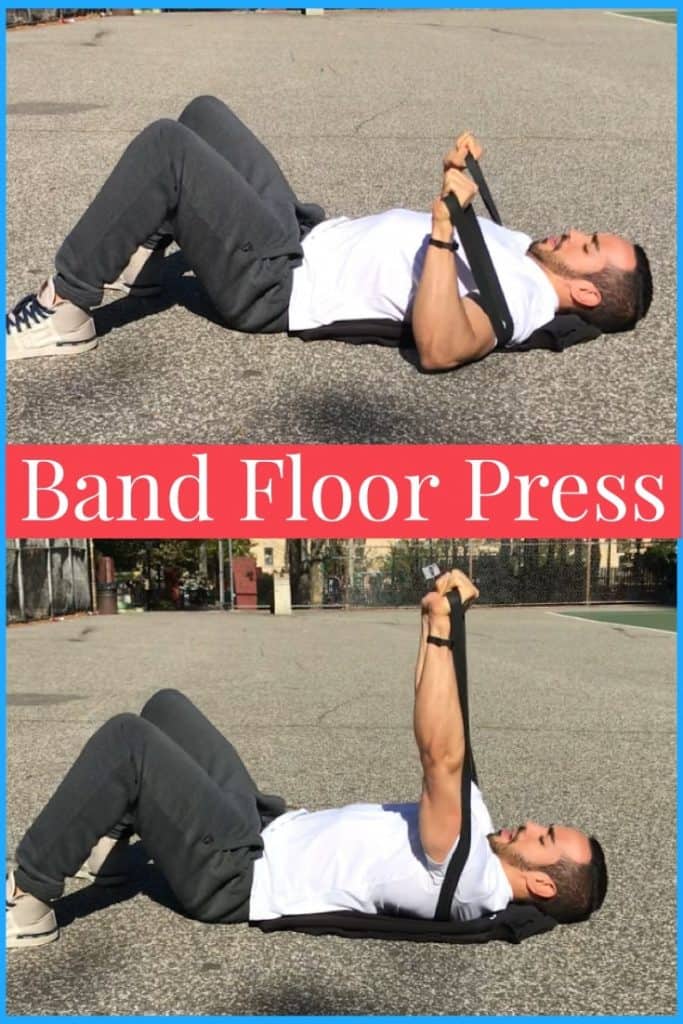Horizontal push exercises are the key to developing the front half of your upper body.
In this post, you will learn:
- What muscles are worked in the horizontal push
- 15 variations you can do with weights or at home
- How to do these movements correctly
Let’s get started.

What is a horizontal exercise?
A horizontal exercise is one in which your arms move perpendicular to your body (i.e., directly in front of you).
Horizontal pushing exercises are where your hands move away from you, while horizontal pulling exercises are where you bring your hands closer to you.
What Muscles Does the horizontal push work?
Horizontal pushes train the powerful muscle groups on the anterior side of your upper body. These include the chest, deltoids, serratus anterior, and even the triceps.
What’s great about these exercises is that you can change your hand placement to target different prime movers or emphasize one muscle group over the other.
I’ll show you how below.
How do you do a horizontal push?
The horizontal push is any exercise where you flex and extend your elbows directly in front of your body.
These elbow extension exercises can be done while seated, standing, laying on your back, or from a push-up position.
When doing a horizontal push, you must pay attention to what your scapulae are doing.
Specifically, your scapula (shoulder blades) must retract when you are at the bottom of the movement (when your elbows are completely flexed).
What are examples of push exercises?
The most common examples of horizontal push exercises are:
- The bench press
- The incline press
- The dumbbell bench press
- The machine chest press
- The cable press
- The floor press
- Push-ups, and
- Dips
Let’s go over these basic movement patterns, including several variations you can do with each exercise.
The exercises are stratified by the equipment you need to do them.
Horizontal Push Exercises With Weights
The two main types of horizontal push exercises with weights include:
- Bench press variations and
- Incline press variations
Here’s how to do the best ones.
Barbell Bench Press
The bench press is the most well-known horizontal push exercise.
- Lie on your back on a bench press loaded with a barbell with your desired weight
- Ensure that the barbell is at a height where your elbows are slightly bent when you reach up to grab it
- Grab the barbell with your hands slightly wider than shoulder-width
- Retract your shoulder blades and maintain this position the entire time
- Position your feet flat on the ground with your butt engaged and in contact with the bench
- Unrack the bar with straight elbows and bring the bar above your nipple line
- Inhale and start lowering the bar slowly by TUCKING your elbows in towards your body. DO NOT FLARE THEM OUT.
- Let the bar make contact with your chest slightly below the nipple line and pause briefly
- Reverse the movement by contracting your buttocks, driving your feet into the ground without letting them move, and pressing the weight up and slightly back towards your head
- Exhale as you are pressing
- Do not let your butt come off the bench, and do not let your shoulder blades protract
Close Grip Bench Press
- One of the best variations to the traditional bench press is the close grip variation
- The exercise is the same, except you will grab the bar just shoulder-width apart
- In this variation, your elbows will naturally tuck much closer into your body than the regular bench press
- The remainder of the technique is the same
Low Incline Bench Press
- The incline bench press targets your horizontal pressing muscles from a different angle, emphasizing the upper chest and shoulders more
- Lie on your back on an incline bench press that has a barbell set with your desired weight
- Ensure that the barbell is at a height where your elbows are slightly bent when you reach up to grab it
- The Incline should be ~30-45 degrees
- Retract your shoulder blades and maintain this position the entire time
- Position your feet flat on the ground with your butt engaged and in contact with the bench
- Un-rack the bar with straight elbows and bring the bar directly over your clavicle (collar bones)
- Inhale and start lowering the bar slowly by TUCKING your elbows in towards your body. DO NOT FLARE THEM OUT.
- Let the bar make contact with your upper chest slightly below your clavicles and pause briefly
- Reverse the movement by contracting your buttocks, driving your feet into the ground without letting them move, and pressing the weight up and slightly back towards your head
- Exhale as you are pressing
- Do not let your butt come off the bench, and do not let your shoulder blades protract
Machine Chest Press
- The machine chest press is much easier to perform than a free weight press
- Sit on the machine press with your desired weight selected
- Make sure that the handles are at the height of your nipple line
- Retract your shoulder blades and maintain this position the entire time
- Position your feet flat on the ground and brace your core
- Begin pressing the handles straight out in front of you until your elbows are locked out
- Slowly lower the weight back down to the starting position as you inhale
Cable Chest Press
- The chest press can also be done with a cable machine from a standing position
- This exercise will require a double cable pulley machine with two separate handles
- Set the cable pulley machine at the level of your chest with your desired weight
- Grab the handles and turn away from the machine
- The remainder of the technique is the same
- Keep your shoulder blades retracted and press from a tucked elbow position
Horizontal Push Exercises With Dumbbells
You can perform many of the same exercises mentioned above with dumbbells.
The best exercise is the dumbbell bench press.
Dumbbell Bench Press
- Select two dumbbells of your choice and sit down on the edge of a flat bench
- Position the dumbbells on your lower legs in a vertical orientation right above your knees
- Retract your shoulder blades and maintain this position the entire time
- Using controlled momentum, lay yourself down while simultaneously raising the dumbbells to your chest
- Make sure that your scapulae are still retracted
- Keep your elbows tucked at a 45-degree angle and the dumbbells angled slightly
- Position your feet flat on the ground with your butt engaged and in contact with the bench
- Begin with pressing the weight straight up and slightly back towards your face until your elbows are locked out
- Bring the weight back down until they are touching your chest by tucking your elbows to about 45 degrees
- When you are done, try to control the weights down to the floor – do not drop them from a high position
Neutral Grip Dumbbell Bench Press
- The neutral grip dumbbell bench press is the same as the regular dumbbell bench press above but with a different hand position
- Position yourself the same way as you did in the previous exercise, but instead of holding the dumbbells with your palms facing forward, you will hold the dumbbells with your palms facing each other
- This grip will emphasize the triceps more and resemble a close grip bench press
- Keep the weight tucked in close to your body as you are lowering and pressing the weight
Low Incline Dumbbell Bench Press
- The low incline dumbbell press is performed the same as the regular dumbbell bench press
- Instead, you will use an incline bench that is set to an incline at ~30-45 degrees
- All of the same technical cues apply
- Make contact with the dumbbells on your upper chest
Dumbbell Floor Press
- The floor press is a great exercise that provides the same benefit without the need for a bench
- Select two dumbbells of your choice and sit down on the floor with your legs straight out in front of you
- Position the dumbbells on your lower legs in a vertical orientation right above your knees
- Retract your shoulder blades and maintain this position the entire time
- Using controlled momentum, lay yourself down on the floor while simultaneously raising the dumbbells to your chest
- Keep your knees bent with your feet flat on the floor
- You won’t be able to make contact with your chest, as your elbows wont be able to flex all the way (i.e., your upper arms will be flat on the floor)
- From here, press the dumbbells straight up toward the sky until your elbows are locked out
- Slowly lower the weight until your upper arms are again flat on the floor
If you would like to see how to combine all the best compound exercises and more into a workout routine, download the WCT’s Workout Template.
You’ll also learn the other key exercise categories to train your entire body, which includes:
- the best horizontal pull exercises
- the best vertical pulling exercises
- the best vertical pushing exercises
- the best squat variations
- the best hip hinge variations
Horizontal Push Exercises With Bodyweight (No Equipment)
Next, let’s go over some simple bodyweight-based push exercises you can do with no equipment.
The following exercises are classics and represent some fundamental basic movement patterns.
Push-ups
- Squat down and place your hands on the floor at about shoulder-width
- Straighten your legs out behind you so that your body makes a straight line
- Brace your core and squeeze your glutes and maintain these muscles engaged the entire time
- Begin the descent by tucking your elbows to a 45-degree angle to your body
- As you descend, make sure that your spinal alignment doesn’t change
- At the bottom position, make sure to retract your shoulder blades
- Reverse the movement by pushing through your hands and extending your elbows
Close Grip Push-ups
- The close-grip push-up is exactly like the regular push-up but with a slightly closer hand position
- As always, keep your core tight, and glutes engaged, and do not let your hip sag or arch
Decline Push-ups
- The decline push-up is done with your feet on an elevated platform – usually a bench, box or a chair
- This will shift more of your body weight onto your upper chest and shoulders
- The remainder of the exercise is pretty much the same
Dips
- Find two tall parallel bars or some sturdy chairs that can support your body weight
- Press your hands down onto the bars with straight elbows to lift your body off the ground
- Make sure to keep your core tight and avoid shrugging
- You may need to cross your legs behind you
- Begin the descent by tucking your elbows close in toward your body
- It is essential that you keep your shoulders back and do not let them roll forward in your socket
- The best way to maintain good form is to keep your chest proud and retract your shoulder blades as you reach the bottom
- It is normal for your upper body to have some forward lean to target the chest more
Horizontal Push Exercises At Home
Last but not least, let’s go over a couple more exercises you can do at home with the aid of a
These are the bands I recommend.
These exercises are a good starting point for those with less experience.
Resistance Band Chest Press

- Wrap the resistance band around on a sturdy pole or beam at chest level and place your hands inside the two loops at the end of either side
- Face away from the pole so that the band is providing resistance behind you
- Bring the two loops up to your chest and keep your shoulder blades retracted
- From here, press your arms straight out in front of you without protracting your shoulder blades
Resistance Band Floor Press

- Wrap the resistance band around your upper back and place your hands inside the two loops at the end of either side.
- Lie down on your back with your fist pointing up at the ceiling and elbows and upper arms flat on the floor
- Retract your shoulder blades and maintain this position throughout the entire movement
- Press the bands up towards the sky and slowly lower them back down
Other Related Questions
What are all the push muscles?
The primary push muscle includes:
- the pectoralis major
- the anterior deltoid
- the medial deltoid
- the triceps
Are push ups horizontal?
Yes, push-ups are a horizontal pushing exercise because the resistance is being applied directly in front of your body. When done correctly, push-ups are a great way to train the chest muscles and anterior shoulder muscles.
Is The deadlift push or pull?
Although the deadlift seems like a pulling exercise, it is actually a lower-body pushing exercise. If you think about it, you are pushing your legs into the ground so that you can extend your knees while holding on to the bar.
Check out my deadlift tutorial here.
What is a vertical exercise?
A vertical exercise is one in which your arms move parallel to your body (i.e., straight up above your head).
You can perform a vertical push or a vertical pull, each one training different muscle groups.
Vertical pushing exercises train the shoulders and triceps. In contrast, vertical pulling exercises train the latissimus dorsi, biceps, posterior deltoids, and trapezius muscles.
- The most common vertical pushing exercise is the overhead press.
- The most common vertical pulling exercise is the lat pulldown.
How many exercises should be in a push workout?
Ideally, you should perform 3-4 exercises per workout. Stick with those same exercises for at least 6-8 weeks to maximize each movement’s benefits.
Final Words
So there you have the 15 best horizontal pushing exercises to get a stronger and more defined chest, shoulders, and triceps.
As always, make sure to use proper form whenever you do any exercise activity.
Which horizontal push exercise are you going to add to your workout program?
Comment below and let us know!
If you struggle with exercise selection, check out our complete list of the best strength training exercises here.
Related Posts:

Alex Robles, MD, CPT / Brittany Robles, MD, MPH, CPT
Alex & Brittany Robles are physicians, NASM Certified Personal Trainers, and founders of The White Coat Trainer: a resource dedicated to improving the health and fitness of busy professionals using time-efficient strategies. Their advice has been featured in My Fitness Pal, Prevention, Livestrong, Reader’s Digest, Bustle, The Active Times, and more. Learn more about them here.
